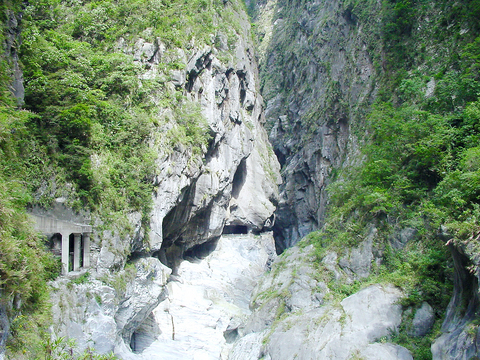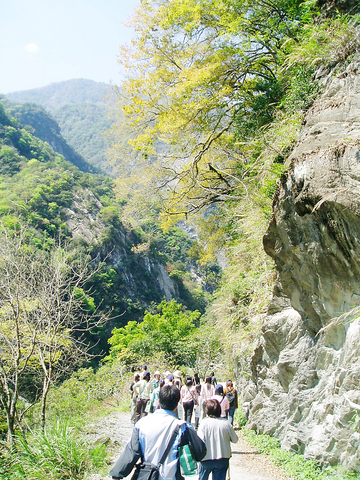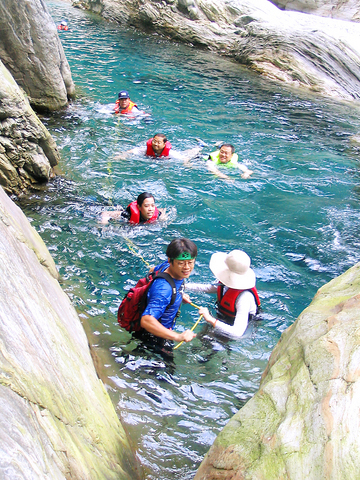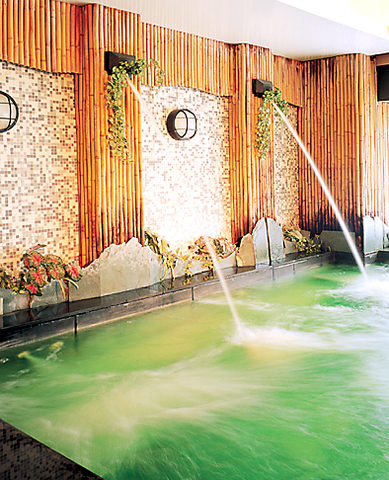You may have seen or walked through Taroko Gorge in Hualien and been enthralled by its beauty. On a clear day, you may have even heard loud laughter as three or four Taroko Aboriginal tribal youths swam in a stream winding along the trail you were hiking.
This is a common experience for those who have visited this magnificent natural wonder of the world. However, stream-tracing -- hiking up a riverbed to its origin -- at Taroko Gorge is something only a lucky few have been able to do up to this point.
It's now summer, however, and the Taroko National Park Administration Center (

PHOTOS COURTESY OF THE GRAND FORMOSA TAROKO
"Adventure-seeking tourists may register with the Grand Formosa Taroko Resort Hotel one day ahead of time, and they will be led by qualified coaches and local guides with the proper gear to enjoy the daring experience," said Grand Formosa Taroko's supervisor Sandy Wang (
Different river-tracing packages are available, with a price of about NT$800 per person for a half-day tour covering around 2km of the waterway.
Indisputably, the Shakadang (or Skadang) Stream (

As Lee Yen-jung (
Shakadang Stream is a branch of the Liwu River (
The Japanese in the old days chiseled a 1m-wide walkway on one side of the Shakadang river valley in order to build a dam upstream of the river. The track, now popularly known as the Shakadang Walkway (

The entrances to the walkway and the river bed are located at opposite ends of a bridge decorated with 100 small marble lions. The Shakadang Bridge, or Hundred-Lions Bridge, links up two curving tunnels on Provincial Route 8. From one of the bridge ends, you have to take a steep stairway down about six stories to reach the river and walkway.
If you are not a fan of water sports, you may simply hike along the walkway to observe your family members or friends struggling up the stream about 20m to 30m below the trail. A pair of binoculars would come in handy if you'd like to witness their facial expressions and to share the moments of excitement once a difficult barrier is overcome by the stream-tracers.
The most fascinating section of Shakadang Stream is about 1km away from the entrance. This beautiful section is banked by lofty marble walls on both sides, and the atmosphere has a dream-like feeling.

Meanwhile, huge marble boul-ders fill the riverbed to create rapids, and there are little water falls and various ponds. One wonders how so many giant rocks found their way there, and one cannot but feel humbled by the immeasurable power of Mother Nature.
The word "shakadang" is an Aboriginal term meaning "molar tooth." It is believed that the stream's name was derived from the fact that many molars -- which local Aborigines believed were part of their ancestors' remains -- were found on the trail at the time when the footpath was constructed by the Japanese.
This cool and refreshing scenic trail is well-canopied with trees and ferns, and birds and butterflies are abundant along the roadside. Sometimes you may even see Formosan macaques playing in a small group high up in the trees.

The track is never desolate, even in midwinter. It is 4.4km in length and takes approximately four hours to make a round trip.
More information:
Where to stay:
The Grand Formosa Taroko in Hualien
Special rates:
NT$2,450 a night per person for each couple until the end of August.
Tour package includes one-night stay, breakfast, dinner, transportation to and from Hualien train station or airport, free use of hotel facilities, etc.
Web site:
www.grandformosa-taroko.com.tw
Contact:
Taipei: (02) 2560 3266
Hualien: (03) 869 1155
Kaohsiung: (07) 215 2733
Restaurant
Chefs at the Grand Formosa put a lot of effort into preparing a great variety of food for their hotel guests and change their menus in keeping with the seasons.
As Simmone Kao (高曉慧), a senior staff member of the Grand Formosa points out, Chinese herbs, Western herbs, seasonal fruits and other health-conscious ingredients are always emphasized in the hotel's dishes.
Fruits available daily during Taiwan's summer season include oranges, kiwis, durians, bananas, pineapples, mangos, pumpkins, apples, cherries, strawberries and passion fruits. And these are often combined by the chefs for their signature dishes.
Among the dishes most frequently recommended by the hotel's old-timers are deep-fried trout and pineapple roll, sliced beef with mango sauce, steamed rice with pumpkin mash and baked crab with cream apple mash. The secret to the fantastic taste of each course lies, perhaps, in the exclusive home-made sauces or gravies.
Also, many menu items are intended to improve your health in a particular way and you may inquire about the particular health benefits of a meal with your waiter.

That US assistance was a model for Taiwan’s spectacular development success was early recognized by policymakers and analysts. In a report to the US Congress for the fiscal year 1962, former President John F. Kennedy noted Taiwan’s “rapid economic growth,” was “producing a substantial net gain in living.” Kennedy had a stake in Taiwan’s achievements and the US’ official development assistance (ODA) in general: In September 1961, his entreaty to make the 1960s a “decade of development,” and an accompanying proposal for dedicated legislation to this end, had been formalized by congressional passage of the Foreign Assistance Act. Two

Despite the intense sunshine, we were hardly breaking a sweat as we cruised along the flat, dedicated bike lane, well protected from the heat by a canopy of trees. The electric assist on the bikes likely made a difference, too. Far removed from the bustle and noise of the Taichung traffic, we admired the serene rural scenery, making our way over rivers, alongside rice paddies and through pear orchards. Our route for the day covered two bike paths that connect in Fengyuan District (豐原) and are best done together. The Hou-Feng Bike Path (后豐鐵馬道) runs southward from Houli District (后里) while the

On March 13 President William Lai (賴清德) gave a national security speech noting the 20th year since the passing of China’s Anti-Secession Law (反分裂國家法) in March 2005 that laid the legal groundwork for an invasion of Taiwan. That law, and other subsequent ones, are merely political theater created by the Chinese Communist Party (CCP) to have something to point to so they can claim “we have to do it, it is the law.” The president’s speech was somber and said: “By its actions, China already satisfies the definition of a ‘foreign hostile force’ as provided in the Anti-Infiltration Act, which unlike

Mirror mirror on the wall, what’s the fairest Disney live-action remake of them all? Wait, mirror. Hold on a second. Maybe choosing from the likes of Alice in Wonderland (2010), Mulan (2020) and The Lion King (2019) isn’t such a good idea. Mirror, on second thought, what’s on Netflix? Even the most devoted fans would have to acknowledge that these have not been the most illustrious illustrations of Disney magic. At their best (Pete’s Dragon? Cinderella?) they breathe life into old classics that could use a little updating. At their worst, well, blue Will Smith. Given the rapacious rate of remakes in modern